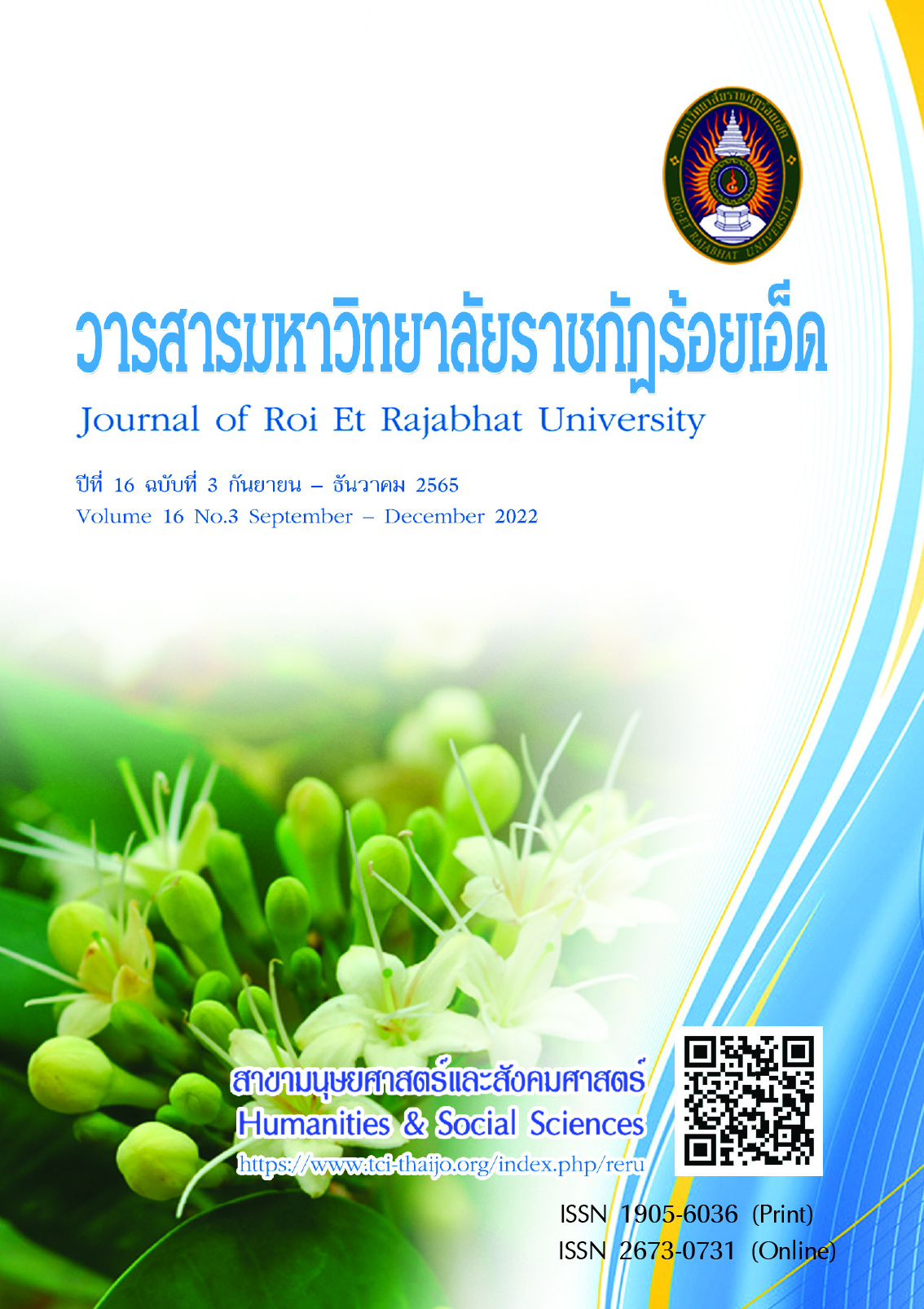การพัฒนารูปแบบการเรียนการสอนคณิตศาสตร์ ตามทฤษฎีการสร้างความรู้ด้วยตนเอง เพื่อส่งเสริมความสามารถในการแก้ปัญหา เรื่อง เซต สำหรับนักเรียนชั้นมัธยมศึกษาปีที่ 4
คำสำคัญ:
รูปแบบการเรียนการสอน, ทฤษฎีการสร้างความรู้ด้วยตนเอง, ความสามารถการแก้ปัญหาบทคัดย่อ
การวิจัยครั้งนี้มีความมุ่งหมายเพื่อ 1) สร้างและหาประสิทธิภาพของรูปแบบการเรียนการสอนคณิตศาสตร์ ตามทฤษฎีการสร้างความรู้ด้วยตนเอง เพื่อส่งเสริมความสามารถในการแก้ปัญหา เรื่อง เซต สำหรับนักเรียนชั้นมัธยมศึกษาปีที่ 4
2) ศึกษาผลการใช้รูปแบบการเรียนการสอนคณิตศาสตร์ ตามทฤษฎีการสร้างความรู้ด้วยตนเอง เพื่อส่งเสริมความสามารถ
ในการแก้ปัญหา เรื่องเซต สำหรับนักเรียนชั้นมัธยมศึกษาปีที่ 4 และ 3) ศึกษาความพึงพอใจของนักเรียนที่มีต่อการเรียน
ด้วยรูปแบบการเรียนการสอนคณิตศาสตร์ ตามทฤษฎีการสร้างความรู้ด้วยตนเอง เพื่อส่งเสริมความสามารถในการแก้ปัญหา
เรื่องเซต สำหรับนักเรียนชั้นมัธยมศึกษาปีที่ 4 กลุ่มตัวอย่างที่ใช้ในการวิจัย ได้แก่ นักเรียนชั้นมัธยมศึกษาปีที่ 4/5 โรงเรียนบัวขาว อำเภอกุฉินารายณ์ จังหวัดกาฬสินธุ์ ภาคเรียนที่ 1 ปีการศึกษา 2562 จำนวน 38 คน โดยการสุ่มแบบกลุ่ม เครื่องมือที่ใช้
ในการวิจัย ได้แก่ 1) รูปแบบการเรียนการสอนคณิตศาสตร์ 2) แผนการจัดการเรียนรู้ 3) แบบทดสอบวัดผลสัมฤทธิ์ทางการเรียน 4) แบบทดสอบการคิดแก้ปัญหา และ 5) แบบวัดความพึงพอใจของนักเรียนที่มีต่อการเรียนด้วยรูปแบบการเรียนการสอนคณิตศาสตร์ สถิติที่ใช้ในการวิเคราะห์ข้อมูล ได้แก่ ค่าร้อยละ ค่าเฉลี่ย ส่วนเบี่ยงเบนมาตรฐาน สถิติทีแบบไม่อิสระ (t-test dependent) และการวิเคราะห์เนื้อหา ผลการวิจัยปรากฏ ดังนี้
- รูปแบบการเรียนการสอนคณิตศาสตร์ ตามทฤษฎีการสร้างความรู้ด้วยตนเอง เพื่อส่งเสริมความสามารถ
ในการแก้ปัญหา เรื่องเซต สำหรับนักเรียนชั้นมัธยมศึกษาปีที่ 4 ที่ผู้วิจัยพัฒนาขึ้น มีชื่อเรียกว่า “PCAPRE Model”
มี 5 องค์ประกอบ คือ หลักการ วัตถุประสงค์ เนื้อหา กระบวนการเรียนการสอน และการวัดและประเมินผล รูปแบบ
มีกระบวนการจัดการเรียนการสอน 6 ขั้นตอน ได้แก่ ขั้นเตรียมพร้อมในการเรียน (Preparation: P) ขั้นสร้างความรู้
และแก้ปัญหา (Construction and Problem solving: C) ขั้นฝึกปฏิบัติ (Action: A) ขั้นนำเสนอผลงาน (Presentation: P) ขั้นสะท้อนความคิด (Reflection: R) ขั้นการประเมินผล (Evaluation: E) มีผลการประเมินความเหมาะสมของรูปแบบ
อยู่ในระดับมากที่สุด และมีประสิทธิภาพ (E1 /E2) เท่ากับ 80.13 / 81.32 ซึ่งสูงกว่าเกณฑ์ที่ตั้งไว้ 75/75 - ผลการทดลองใช้รูปแบบการเรียนการสอนที่ผู้วิจัยพัฒนาขึ้น พบว่า 2.1) นักเรียนชั้นมัธยมศึกษาปีที่ 4
มีผลสัมฤทธิ์ทางการเรียนหลังเรียนสูงกว่าก่อนเรียนอย่างมีนัยสำคัญทางสถิติที่ระดับ .05 2.2) นักเรียนชั้นมัธยมศึกษาปีที่ 4
มีความสามารถในการแก้ปัญหาสูงกว่าเกณฑ์ร้อยละ 75 อย่างมีนัยสำคัญทางสถิติที่ระดับ .05 2.3) ดัชนีประสิทธิผลของรูปแบบการเรียนการสอนคณิตศาสตร์ ตามทฤษฎีการสร้างความรู้ด้วยตนเอง เพื่อส่งเสริมความสามารถในการแก้ปัญหา เรื่องเซต
สำหรับนักเรียนชั้นมัธยมศึกษาปีที่ 4 มีค่าเท่ากับ 0.7197 หมายความว่า นักเรียนมีความก้าวหน้าในการเรียนรู้ คิดเป็นร้อยละ 71.97 - ความพึงพอใจของนักเรียนที่มีต่อการเรียนด้วยรูปแบบการเรียนการสอนคณิตศาสตร์ ตามทฤษฎีการสร้างความรู้ด้วยตนเอง เพื่อส่งเสริมความสามารถในการแก้ปัญหา เรื่องเซต สำหรับนักเรียนชั้นมัธยมศึกษาปีที่ 4 มีความพึงพอใจโดยรวม
อยู่ในระดับมากที่สุด
เอกสารอ้างอิง
ทิศนา แขมมณี. (2554). ศาสตร์การสอน: องค์ความรู้เพื่อการจัดกระบวนการเรียนรู้ที่มีประสิทธิภาพ. กรุงเทพฯ: โรงพิมพ์แห่งจุฬาลงกรณ์มหาวิทยาลัย.
ทิศนา แขมมณี. (2550). ศาสตร์การสอน: องค์ความรู้เพื่อการจัดการกระบวนการเรียนรู้ที่มีประสิทธิภาพ (พิมพ์ครั้งที่ 2). กรุงเทพฯ: โรงพิมพ์แห่งจุฬาลงกรณ์มหาวิทยาลัย.
ธีร์ธวัช ปิ่นทุมมา และกนิษฐา เชาว์วัฒนกุล (2560: 25-36). การพัฒนารูปแบบการจัดการเรียนรู้เพื่อส่งเสริมความสามารถในการแก้ปัญหาทางคณิตศาสตร์ของนักเรียนชั้นมัธยมศึกษาปีที่ 3. ศาสตร์การศึกษาและพัฒนามนุษย์, 1(1), 25-36.
นันทิยา บุญเคลือบ. (2540). มาตรฐานการศึกษาวิทยาศาสตร์. วารสาร สสวท, 25(99), 7-12.
บุญเชิด ภิญโญอนนัตพงษ.์ (2540). การทดสอบแบบอิงเกณฑ์: แนวคิดและวิธีการ. กรุงเทพฯ: โอเดียนสโตร์.
ประมวล อุทัยแสง. (2563). การพัฒนารูปแบบการเรียนการสอนเพื่อส่งเสริมความสามารถในการแก้ปัญหาทางคณิตศาสตร์ สำหรับนักเรียนชั้นมัธยมศึกษาปีที่ 3. วารสารมหาวิทยาลัยราชภัฏร้อยเอ็ด, 14(2), 63-75.
ฝ่ายบริหารงานวิชาการ โรงเรียนบัวขาว. (2561). รายงานผลการประเมินผลสัมฤทธิ์ทางการเรียนกลุ่มสาระการเรียนรู้คณิตศาสตร์ ประจำปีการศึกษา 2560-2561. กาฬสินธุ์: โรงเรียนบัวขาว.
พัชรี ปิยภัณฑ์. (2555). การพัฒนารูปแบบการจัดการเรียนรู้ เพื่อส่งเสริมความสามารถในการแก้ปัญหาทางคณิตศาสตร์ สำหรับนักเรียนชั้นมัธยมศึกษาปีที่ 3. ดุษฎีนิพนธ์ การศึกษาดุษฎีบัณฑิต สาขาวิชาการวิจัยและพัฒนา. กรุงเทพฯ: มหาวิทยาลัยศรีนครินทรวิโรฒ.
วัชรา เล่าเรียนดี. (2554). รูปแบบและกลยุทธ์การจัดการเรียนรู้เพื่อพัฒนาทักษะการคิด (พิมพ์ครั้งที่ 7). นครปฐม: โรงพิมพ์มหาวิทยาลัยศิลปากร.
วิลาวัณย์ บุตรพรม. (2556). การพัฒนารูปแบบการเรียนการสอนตามทฤษฎีการสร้างความรู้ เพื่อส่งเสริมความสามารถในการคิดขั้นสูงกลุ่มสาระการเรียนรู้คณิตศาสตร์ ของนักเรียนชั้นมัธยมศึกษาปีที่ 3. ร้อยเอ็ด: โรงเรียนเทศบาลวัดป่าเรไร.
วิไลพร พงษ์พล. (2560). การพัฒนารูปแบบการสอนคณิตศาสตร์ ประกอบแบบฝึกทักษะ เรื่องเซต เพื่อส่งเสริมความสามารถในการคิดวิเคราะห์และจิตตนิสัยของนักเรียนชั้นมัธยมศึกษาปีที่ 4. ศรีสะเกษ: โรงเรียนพรานวิบูลวิทยา.
สถาบันส่งเสริมการสอนวิทยาศาสตร์และเทคโนโลยี. (2553). คู่มือครูรายวิชาพื้นฐาน คณิตศาสตร์ชั้นมัธยมศึกษาปีที่ 4 กลุ่มสาระการเรียนรู้คณิตศาสตร์ ตามหลักสูตรแกนกลาง การศึกษาขั้นพื้นฐาน พุทธศักราช 2551. กรุงเทพฯ: สถาบันส่งเสริมการสอนวิทยาศาสตร์และเทคโนโลยี.
สำนักงานเลขาธิการสภาการศึกษา. (2550) รูปแบบการจัดการเรียนรู้เพื่อพัฒนาความสามารถของเด็กในการอ่าน คิดวิเคราะห์ เขียน และสร้างองค์ความรู้ด้วยตนเอง โดยเน้นผู้เรียนเป็นสำคัญ. กรุงเทพฯ: สำนักงานเลขาธิการสภาการศึกษา.
สิริพร ทิพย์คง. (2556). การแก้ปัญหาคณิตศาสตร์ (พิมพ์ครั้งที่ 2). กรุงเทพฯ: โรงพิมพ์ สกสค. ลาดพร้าว.
สุนีย์ เหมะประสิทธิ์. (2540). การทำวิจัยเชิงปฏิบัติการสำหรับผู้บริหารและครู. วารสารการวิจัยทางการศึกษา, 21(3), 37.
สุวิทย์ มูลคำ และอรทัย มูลคำ. (2550). 19 วิธีการจัดการเรียนรู้: เพื่อพัฒนาความรู้และทักษะ (พิมพ์ครั้งที่ 5). กรุงเทพฯ: ดวงกมลสมัย.
เสาวภา พรหมทา. (2559). การพัฒนารูปแบบการจัดการเรียนรู้ตามแนวทฤษฎีการสร้างความรู้ด้วยตนเอง เพื่อส่งเสริมทักษะความคิดสร้างสรรค์ รายวิชาการประยุกต์ งานประดิษฐ์ สำหรับนักเรียนชั้นมัธยมศึกษาปีที่ 4. ศรีสะเกษ: โรงเรียนไพรบึงวิทยาคม.
หทัยรัตน์ พงษ์พานิช. (2557). การพัฒนารูปแบบการเรียนการสอนตามทฤษฎีการสร้างความรู้ ร่วมกับเทคนิคผังกราฟิก เพื่อส่งเสริมความสามารถในการคิดวิเคราะห์ ของนักเรียนชั้นมัธยมศึกษาปีที่ 6. กรุงเทพฯ: โรงพิมพ์ สกสค. ลาดพร้าว.
อัญชลี แก้ววิเศษ. (2559). การพัฒนารูปแบบการเรียนการสอนตามทฤษฎีการสร้างความรู้ ด้วยตนเอง โดยการสร้างสรรค์ชิ้นงาน เพื่อส่งเสริมความคิดสร้างสรรค์และทักษะอาชีพในการจัดการเรียนรู้ศตวรรษที่ 21 เรื่องงานประดิษฐ์จากผ้าลายไทย กลุ่มสาระการเรียนรู้การงานอาชีพและเทคโนโลยี ของนักเรียนชั้นมัธยมศึกษาปีที่ 1 โรงเรียนเทศบาลจุ่งฮั่ว. พัทลุง: โรงเรียนเทศบาลจุ่งฮั่ว.
Bruner, J. S. (1976). Jerome Bruner and Process of Education. Retrieved February 17, 2019, from http://www.infed.org/thinkers/bruner.htm/
Dewey, J. (2007). How We Think. Retrieved December 1, 2018, from http://www.scribd.com/doc/7601735/Dewey-Pattern-Problem-solving-agenda/
Driver, R. H. and Bell, B. (1986). Students thinking and the learning of science: A constructivist view. The School Review, 67(240), 443-456.
George, J. M. and Jones, G. R. (2006). Understanding and mamaging: Organizational Behavior (2nd ed.). Massachusetts: Addison–Wesley.
Guilford, J. P. (1982). Fundamental Statistics in Psychology and Education (4th ed.). Tokyo: McGraw-Hill Kodakusha.
Kruse, Kevin. (2007). Instruction to instructional design and the ADDIE model. Retrieved June, 19, from http: www.e-learningguru.com/articles/art1_1.htm
Martin, R. E. (1994). Teaching Science for all Children. Boston: Allyn & Bacon.
Joyce, B. and Weil, M. (2000). Models of Teaching (6th ed.). Massachusetts: Allyn & Bacon.
Polya, G. (1957). On solving mathematical problems in high school. Reston. Virginia: NCTM.
Weir, J. J. (2005). Problem Solving is Everybody’s Problem. New York: Science Teacher.
Wilson, J. W. and Femandez, M. L. (1993). Mathematical Problem Solving. New York: Macmillan Publishing.
Yager, R. E. (1991). The constructivist learning model. The science teacher, 58(September), 52–57.
ดาวน์โหลด
เผยแพร่แล้ว
รูปแบบการอ้างอิง
ฉบับ
ประเภทบทความ
สัญญาอนุญาต
ลิขสิทธิ์ (c) 2022 มหาวิทยาลัยราชภัฏร้อยเอ็ด

อนุญาตภายใต้เงื่อนไข Creative Commons Attribution-NonCommercial-NoDerivatives 4.0 International License.
บทความที่ได้รับการตีพิมพ์เป็นลิขสิทธิ์ของวารสารมหาวิทยาลัยราชภัฎร้อยเอ็ด
ข้อความที่ปรากฏในบทความแต่ละเรื่องในวารสารวิชาการเล่มนี้เป็นความคิดเห็นส่วนตัวของผู้เขียนแต่ละท่านไม่เกี่ยวข้องกับมหาวิทยาลัยราชภัฎร้อยเอ็ด และคณาจารย์ท่านอื่นๆในมหาวิทยาลัยฯ แต่อย่างใด ความรับผิดชอบองค์ประกอบทั้งหมดของบทความแต่ละเรื่องเป็นของผู้เขียนแต่ละท่าน หากมีความผิดพลาดใดๆ ผู้เขียนแต่ละท่านจะรับผิดชอบบทความของตนเองแต่ผู้เดียว





